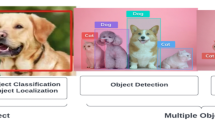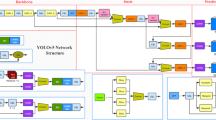Abstract
Traditional cameras can only record videos passively. If the camera can further automatically recognize human behavior and activity, it can immediately issue an alarm to notify the monitor or guards when abnormal behavior is detected. Hence, the monitor or guard can quickly take relevant actions based on the detected behavior. In this paper, we propose a deep learning model for abnormal behavior detection, which use object detection technology YOLOv3 to detect pedestrians, and then use hybrid Deep-SORT algorithm to track pedestrians to obtain tracking trajectories from the sequence frames. Then, the convolutional neural network (CNN) is used to extract the action characteristics of each tracked trajectory, and the long short-term memory network (LSTM) is used to build anomalous behavior identification model to predict abnormal behavior, such as falling, kicking, punching, etc. The experimental results show that the proposed method has a good recognition rate in different behavior data sets, and it can also meet the needs of real-time monitoring.








Similar content being viewed by others
References
Aliet S, Shah M (2010) Human action recognition in videos using kinematic features and multiple instance learning. IEEE Trans Pattern Anal Mach Intell 32(2):288–303
Alwan M et al (2006) A smart and passive floor-vibration based fall detector for elderly. In: 2nd International Conference on Information and Communication Technologies
Arifoglu D, Bouchach A (2017) Activity recognition and abnormal behaviour detection with recurrent neural networks. In: Proc. of MobiSPC. pp 86–93
Belshaw M, Taati B, Giesbercht D, Mihailidis A (2011) Intelligent vision-based fall detection system: preliminary results from a real world deployment. RESNA/ICTA 2011: Advancing Rehabilitation Technologies for an Aging Society
Belshaw M, Taati B, Snoek J, Mihailidis A (2011) Towards a single sensor passive solution for automated fall detection. Conf Proc IEEE Eng Med Biol Soc. pp 1773–1776
Bera A, Kim S, Manocha D (2016) Realtime anomaly detection using trajectory-wise crowd behavior learning. Proceedings of International Conference on Computer Vision and Pattern Recognition, CVPRW’13. pp 50–57
Bermejo NE, Deniz SO, Bueno GG, Rahul S (2011) Violence detection in video using computer vision techniques. In: Proc. of the 14th international conference on computer analysis of images and patterns, CAIP2011, pp 332–339
Bewley A, Ge Z, Ott L, Ramos F, Upcroft B (2016) Simple online and realtime tracking. In: Proc. of IEEE International Conference on Image Processing
Bourke AK, O’Brien JV, Lyons GM (2007) Evaluation of a threshold-based tri-axial accelerometer fall detection algorithm. Gait Posture 26(2):194–199
Bourke AK, van de Ven PW, Chaya AE, OLaighin GM, Nelson J (2008) Testing of a long-term fall detection system incorporated into a custom vest for the elderly. Proc. Of IEEE Conf. on Eng Med Biol Soc. pp 2844–2847
Burkard R, Dell'Amico M, Martello S (2012) Assignment problems. Revised reprint. SIAM - Society of Industrial and Applied Mathematics, Philadelphia
Chaker R, Aghbari ZA, Junejo IN (2017) Social network model for crowd anomaly detection and localization. Pattern Recogn 61:266–281
Charfi I, Miteran J, Dubois J, Atri M, Tourki R (2013) Optimised spatio-temporal descriptors for real-time fall detection: comparison of SVM and Adaboost based classification. J Electron Imaging 22(4):17
Fan Y, Levine MD, Wen G, Qiu S (2017) A deep neural network for real-time detection of falling humans in naturally occurring scenes. Neurocomputing 260:43–58
Feng Y, Yuan Y, Lu X (2017) Learning deep event models for crowd anomaly detection. Neurocomputing 219:548–556
Girshick R (2015) Fast R-CNN. In: The IEEE International Conference on Computer Vision, Santiago, Chile. pp 1440–1448
Girshick R, Donahue J, Darrell T, Malik J (2014) Rich feature hierarchies for accurate object detection and semantic segmentation. In: Proceedings of IEEE Conference on Computer Vision and Pattern Recognition, Columbus, OH, USA, pp 580–587.
Gomez HF, Martinez TR, Arias TS, Fernandez CA, Sylvie R, Gonzalez EA et al (2015) Identification of loitering human behaviour in video surveillance environments. Artif Comput Biol Med 9107:516–525
Guang S, Fu G, Li P, Geng H (2014) Violent behavior detection based on SVM in the elevator. Int J Secur Appl 8:31–40
Harrou F, Zerrouki N, Sun Y, Houacine A (2017)Vision-based fall detection system for improving safety of elderly people. IEEE Instrum Meas Mag 20:19–55
He K, Zhang X, Ren S, Sun J (2016) Deep residual learning for image recognition. In: Proc of IEEE Conference on Computer Vision and Pattern Recognition. pp 770–778
Hochreiter S, Schmidhuber J (1997) Long short-term memory. Neural Comput 9(8):1735–1780
Hu Y (2020) Design and implementation of abnormal behavior detection based on deep intelligent analysis algorithms in massive video surveillance. J Grid Comput 18:227–237
Hu X, Dai J et al (2019) A weakly supervised framework for abnormal behavior detection and localization in crowded scenes. Neurocomputing 383:270–281
Huang Z, Niu Q, Xiao S (2020) Human behavior recognition based on motion data analysis. Int J Pattern Recognit Artif Intell 34(9):2056005
Ioffe S, Szegedy C (2015) Batch normalization: accelerating deep network training by reducing internal covariate shift. arXiv preprint arXiv:1502.03167
Kangas M et al (2009) Sensitivity and specificity of fall detection in people aged 40 years and over. Gait Posture 29(4):571–574
Kim Y, Bang H (2018) Introduction to Kalman filter and its applications. Open access peer-reviewed chapter. https://doi.org/10.5772/intechopen.80600
Kim J, Grauman K (2009) Observe locally, infer globally: a space–time MRF for detecting abnormal activities with incremental updates. Proc. IEEE Conf. Comput. Vis. Pattern Recognition. pp 2921–2928
Laxhammar R, Falkman G (2014) Online learning and sequential anomaly detection in trajectories. IEEE Trans Pattern Anal Mach Intell 36(6):1158–1173
Li Y, Zeng Z, Popescu M, Ho KC (2010) Acoustic fall detection using a circular microphone array. Conf Proc IEEE Eng Med Biol Soc pp 2242–2245
Lin T-Y, Dollar P et al (2017) Feature pyramid networks for object detection. Proc. of IEEE Conference on Computer Vision and Pattern Recognition
Mabrouk AB, Zagrouba E (2018) Abnormal behavior recognition for intelligent video surveillance systems: a review. Expert Syst Appl 91:480–491
Mehran R, Oyama A, Shah M (2009) Abnormal crowd behavior detection using social force model. Proc. IEEE Conf. Comput. Vis. Pattern Recognition. pp 935–942
Nannan L, Xinyu W et al (2015) Anomaly detection in video surveillance via gaussian process, International Journal of Pattern Recognition and Artificial Intelligence. 29(6):1555011
Nguyen VD, Le MT et al (2014) An efficient camera-based surveillance for fall detection of elderly people. In: IEEE 9th conference on Industrial electronics and applications (ICIEA). pp 994–997
Nunezez-Marcos A, Azkune G, Arganda-Carreras I (2017)Vision-based fall detection with convolutional neural networks. Wirel Commun Mob Comput 2017:1–16
Olah C (2015) Understanding LSTM networks. [Online]. Available: https://colah.github.io/posts/2015-08-Understanding-LSTMs/. Accessed 26 June 2019
Pan H et al (2018) Fighting detection based on pedestrian pose estimation. In: 11th International Congress on Image and Signal Processing, BioMedical Engineering and Informatics (CISP-BMEI). pp 1–5
Popescu M, Li Y, Skubic M, Rantz M (2008) An acoustic fall detector system that uses sound height information to reduce the false alarm rate. Conf Proc IEEE Eng Med Biol Soc. pp 4628–4631
Redmon J, Farhadi A (2018) Yolov3: an incremental improvement. arXiv preprint arXiv:1804.02767, 2018.
Redmon J, Divvala S, Girshick R, Farhadi A (2016) You only look once: unified, real-time object detection. In: Proceedings of IEEE Conference on Computer Vision and Pattern Recognition, Las Vegas, NV, USA. pp 779–788
Ren S, He K, Girshick R, Sun J (2015) Faster R-CNN: towards real-time object detection with region proposal networks. IEEE Trans Pattern Anal Mach Intell 39:1137–1149
Ryoo MS, Aggarwal JK (2009)Spatio-temporal relationship match: video structure comparison for recognition of complex human activities. In: IEEE 12th International Conference on Computer Vision, Kyoto, Japan
Stone EE, Skubic M (2015) Fall detection in homes of older adults using the Microsoft Kinect. IEEE J Biomed Health Inform 19:290–301
Tani MK, Lablack A, Ghomari A, Bilasco IM (2015) Events detection using a video-surveillance ontology and a rule-based approach. Computer vision - ECCV 2014 workshops. pp 299–308
Uijlings J, van de Sande K, Gevers T, Smeulders A (2013) Selective search for object. Int J Comput Vis 104(2):154–171
Van Beeck K, Van Engeland K, Vennekens J, Goedemé T (2017) Abnormal behavior detection in LWIR surveillance of railway platforms. 2017 14th IEEE International Conference on Advanced Video and Signal Based Surveillance (AVSS). pp 1–6
Wang XF, He XH et al (2016) A classification method based on streak flow for abnormal crowd behaviors. Optik 127(4):2386–2392
Weiya R, Guohui L, Boliang S, Kuihua H (2015) Unsupervised kernel learning for abnormal events detection. Vis Comput 31:245–255
Welch G, Bishop G (2006) An introduction to the Kalman filter. http://www.cs.unc.edu/~welch/media/pdf/kalman_intro.pdf
Wojke N, Bewley A, Paulus D (2017) Deep SORT: simple online and realtime tracking with a deep association metric. arXiv preprint arXiv:1703.07402
Wu S, Moore BE, Shah M (2010) Chaotic invariants of Lagrangian particle trajectories for anomaly detection in crowded scenes. Proc. IEEE Conf. Comput. Vis. Pattern Recognition. pp 2054–2060
Zhang J, Wu C, Wang Y (2020) Human fall detection based on body posture spatio-temporal evolution. Sensors 20(3):946
Zhao Z-Q, Zheng P, Xu S-t, Wu X (2019) Object detection with deep learning: a review. IEEE Trans Neural Netw Lear Syst 99:1–21
Zhao R, Wang Y, Jia P, Li C, Ma Y, Zhang Z (2021) Abnormal human behavior recognition based on image processing technology. In: IEEE 5th Advanced Information Technology, Electronic and Automation Control Conference (IAEAC). pp 1924–1928
Zhu Y, Wang Z (2016)Real-time abnormal behavior detection in elevator. Intelligent Visual Surveillance: 4th Chinese Conference. pp 154–161
Acknowledgments
This work was supported by the Ministry of Science and Technology, Taiwan, under the grants MOST 109-2637-E-167-004 -.
Author information
Authors and Affiliations
Corresponding author
Additional information
Publisher’s note
Springer Nature remains neutral with regard to jurisdictional claims in published maps and institutional affiliations.
Rights and permissions
About this article
Cite this article
Chang, CW., Chang, CY. & Lin, YY. A hybrid CNN and LSTM-based deep learning model for abnormal behavior detection. Multimed Tools Appl 81, 11825–11843 (2022). https://doi.org/10.1007/s11042-021-11887-9
Received:
Revised:
Accepted:
Published:
Issue Date:
DOI: https://doi.org/10.1007/s11042-021-11887-9




